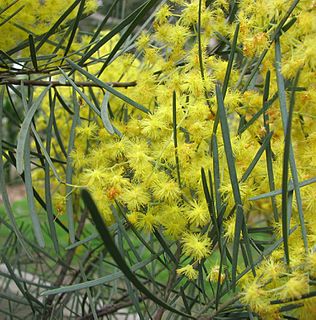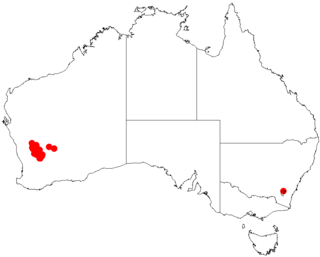
Acacia cognata, commonly known as bower wattle, river wattle or narrow-leaved bower wattle, is a tree or shrub species that is endemic to south eastern Australia.

Acacia conniana is a shrub belonging to the genus Acacia and the subgenus Juliflorae that is endemic to the southern coast of western Australia.

Acacia cracentis is a shrub belonging to the genus Acacia and the subgenus Juliflorae that is endemic to south western Australia.
Acacia epedunculata is a shrub belonging to the genus Acacia and the subgenus Juliflorae that is endemic to a very small area in arid parts of western Australia.

Acacia filamentosa is a shrub belonging to the genus Acacia and the subgenus Juliflorae that is endemic to north western Australia.

Acacia filifolia is a shrub belonging to the genus Acacia and the subgenus Juliflorae that is endemic to western Australia.

Acacia oncinocarpa is a shrub or tree belonging to the genus Acacia and the subgenus Juliflorae that is endemic to northern Australia.

Acacia dentifera, commonly known as tooth-bearing acacia, is a shrub belonging to the genus Acacia and the subgenus Phyllodineae that is endemic to south western Australia.

Acacia rossei, also known as Yellowdine wattle, is a shrub of the genus Acacia and the subgenus Phyllodineae that is endemic to south western Australia.

Acacia validinervia also commonly known as nyalanyalara, nyala nyala, alumaru or blue wattle, is a shrub of the genus Acacia and the subgenus Phyllodineae endemic to arid areas of inland Australia.

Acacia abrupta is a shrub of the genus Acacia and the subgenus Plurinerves that is endemic to arid parts of central and western Australia.

Acacia lobulata, commonly known as Chiddarcooping wattle, is a shrub of the genus Acacia and the subgenus Plurinerves that is endemic to a small area of south western Australia. It was declared as rare flora in 1997 and is now listed a Endangered under the Environment Protection and Biodiversity Conservation Act 1999.

Acacia nivea is a shrub of the genus Acacia and the subgenus Plurinerves that is endemic to south western Australia.

Acacia obtecta is a shrub of the genus Acacia and the subgenus Plurinerves that is endemic to a small area in south western Australia.
Acacia pelophila is a shrub of the genus Acacia and the subgenus Plurinerves that is endemic to a small area along the west coast of western Australia.

Acacia recurvata, commonly known as the recurved wattle, is a shrub of the genus Acacia and the subgenus Plurinerves that is endemic to a small area of western Australia.

Acacia sciophanes, commonly known as the Ghost wattle or Wundowlin wattle, is a shrub of the genus Acacia and the subgenus Plurinerves that is endemic to a small area in south western Australia. In 1995 it was declared as rare in 1995 according to the Western Australian Wildlife Conservation Act 1950 and is listed as endangered under the Environment Protection and Biodiversity Conservation Act 1999.

Acacia trineura, known colloquially as three-nerve wattle or three nerved wattle or green wattle, is a species of Acacia native to south eastern Australia.

Acacia gracilifolia, commonly known as graceful wattle, is a shrub belonging to the genus Acacia and the subgenus Plurinerves native to a small area of central southern Australia.

Acacia cataractae is a shrub belonging to the genus Acacia and the subgenus Juliflorae that is native to northern Australia.


















